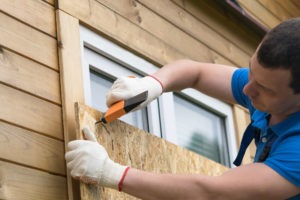 Are you looking to prepare your home for a hurricane? Nobody wants to end up with a torn-down home or a roof with holes. Do you want to know the best way to protect your property from hurricanes? Keep reading for our guide on how to hurricane-proof your home.
Are you looking to prepare your home for a hurricane? Nobody wants to end up with a torn-down home or a roof with holes. Do you want to know the best way to protect your property from hurricanes? Keep reading for our guide on how to hurricane-proof your home.
1. Stock Up on Essentials
The 2018 Atlantic hurricane season that ravaged the US last year taught many Americans to prepare for natural disasters. The 2018 Atlantic hurricane season formed 8 hurricanes, 2 of which were considered major. A total of 15 named storms came from that season, comparable to an average season with 3 major hurricanes out of 6. Still, these hurricanes taught people the importance of preparedness. Take inventory on what you have at home. If you plan on staying in your house to endure the hurricane, stock up on a lot of non-perishable foods. It’s also good to have a battery-operated radio and flashlights in the house. Of course, make sure you have extra batteries for each device. Don’t forget about the essentials if you have a pet.
2. Clean Your Yard
If you want to know how to hurricane-proof your home best, don’t neglect your yard. You want to protect your home from anything that can take flight when the hurricane hits. Often, yards are where flying, destructive debris comes from. Before the storm hits, clear your yard. Secure your lawn furniture, trashcans and yard ornaments. If you have a grill, potted plants or other lawn accessories, bring them inside. It’s also important to remove all dead and dying limbs from your trees. Anything small that you can pick up or carry should get cleared out. A hurricane’s high-speed winds could make any of these items flying missiles. Tie-down larger items like sheds, doghouses and swing sets.
3. Protect and Seal Your Roof
Many people believe the roof is the weakest part of the house, but garage doors and windows are even more vulnerable. No matter how good the condition of your roof, it would be wise to prepare it for the incoming storm. Seal down any chimneys or vent pipes that lead into your house. Clean out any clogged gutters and downspouts as well. Otherwise, the water may spill over the sides and soak through the home’s foundation. If you have roof tiles or shingles, secure them with roofing cement. Disconnect and bring any exterior TV antennas inside, then seal any wire openings. This will help you avoid damages from storms, especially structural and water damages. If you’re afraid that your roof will take wing from the top of your house, reinforce it with uplift protection. You can retrofit your roof with hurricane clips yourself or with professional help. First, don’t forget to talk to a contractor to check the structural integrity of your roof system.
4. Seal Doors and Windows
Do you want to know how to protect windows during hurricane season? As we stated earlier, anything can start flying off during a storm. Your windows may break and let in wind and rain. When wind enters the home, it can increase the pressure under the roof. High-pressure from inside the house can lead to your roof popping off. It’s not too different from a can of soda that has been shaken. To protect your family from this scenario, use storm shutters. They provide great protection for your windows and doors. You can create DIY storm shutters by boarding up your windows. For your doors leading outside, install deadbolts if you don’t already have them. The deadbolts will help hold your doors closed. If possible, you can also install doors that are already made to survive hurricanes. Make sure to install these protective shutters and locks on all sides of the house. Hurricanes may come from a certain body of water in a specific direction from your house, however, they can swirl in any direction too.
5. Reinforce Your Garage Door
Often, your garage door can be one of the weakest links in the home. After all, garage doors are not made to withstand the violent winds of a hurricane. If you have a garage, you should learn how to secure the garage door for a hurricane. Once your garage door goes down, the rest of your house may soon follow. The high-speed winds pressurize the house and then blow off the roof. Check your garage door for a wind or pressure rating. The ideal garage door is a single and windowless door. It should also have the rating to withstand 50 or more pounds of pressure per square foot. If possible, fortify your garage door. You can buy or DIY braces for the garage door which you can disassemble. Use your car as an extra brace for it as well.
6. Take Measures Against Flooding
If you live in flood-prone areas, this is one of those things you shouldn’t forget to do. Check your flood risk and start making a list of things you can do to prepare for flooding situations. Before the flood, you want to reduce the risk of damage from flooding as much as possible. Elevate any electrical appliances and systems. If your area is very prone to flooding, consider elevating the entire home. The Federal Emergency Management Agency (FEMA) has a more extensive guide on how you can protect your home before, during, and after a flood.
7. Get Insurance Coverage
You already know how to prepare your home for a hurricane. Now, let’s talk about what you can do to prep it insurance-wise. Update your insurance and make sure you have the right amount to cover any damages. If you have a homeowner’s insurance, check if there is coverage for storms. If there isn’t, it’s time to start looking into extending the coverage to insurance for storm season. If the insurance company doesn’t have that kind of coverage, start shopping for one that does. When you go shopping for hurricane-related damage insurance, don’t do it right before the storm hits. Most insurance companies may stop selling coverage 48 hours before a hurricane watch. You should also find out if there is a waiting period before the coverage takes effect.
How to Hurricane-Proof Your Home and Stay Safe During Storm Season
That is our quick guide on how to hurricane-proof your home. Follow these steps and you’ll be better prepared during the storm season. If you enjoyed this guide, feel free to check our blog for similar content. For emergency services, questions or concerns, contact us now.
